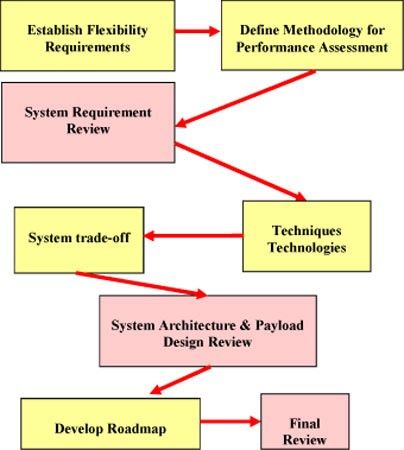
-
StatusCompleted
-
Status date2013-06-11
-
Activity Code1B.034
This study investigates a wide range of techniques and technologies for Ka band (and possibly Q/V bands) for providing higher capacity, more flexible next generation satellite broadband systems. It also develops the methodology for the fair comparison of different systems. Finally the study recommends a technology development roadmap for possible future development.
The main objectives are:
- To capture capacity & flexibility requirements for European systems,
- To consider spectrum (regulatory) issues taking into account both Ka band and Q/V bands,
- To develop a set of scenarios for development,
- To develop a methodology to facilitate the fair comparison of different systems including overall capacity, cost, payload power etc.,
- To provide a review of techniques and technologies that may provide improvements,
- To develop architectures for high capacity and high flexibility at system and payload level,
- To develop the corresponding payload and system architectures,
- To develop a technology roadmap to provide ESA with a plan that will ensure the timely development of the selected new technology.
The fundamental issue was to determine the best technology (or technologies) for providing high speed broadband by geostationary satellite.
The study considered the potential value of Q/V band usage to provide more spectrum.
The study developed its own assessment methodology for the comparison of candidate scenarios
The study found that more spectrum combined with power handling flexibility offered the best solutions. This leads to the conclusion that the use of Q/V band for the feeder links is a desirable step towards higher capacity.
More complex technologies can provide significant flexibility but at the cost of making the payload and platform more expensive due to thermal dissipation and difficulties accommodating TWTAs.
The system architectures under consideration provide high speed broadband access to small fixed user terminals typically on a house. The system connects a large number of users to one or more gateway station that provides interconnection with one (or more) internet service provider. NB mesh architectures involving direct user terminal to user terminal connectivity is not studied. The size of dish envisaged for the user terminals is typically 60cm although larger antennas are considered for use by small business.
Various payload technologies shall be considered and assessed including digital processing, advanced antennas and flexible high power amplification.
The Advanced Scenarios developed during the study can be summarized:
- Advanced Scenario 1 using technology relevant to 2015
Use of Q/V bands for feeder links – use of 2.9GHz of Ka band user links – Single feed per beam antenna system – Multi-Port Amplifiers on forward link. - Advanced Scenario 1 (2020) Use of Q/V band for feeder link. Use of digital processor for agile beam forming through an Array Fed Reflector for Ka-band. Also use of MPAs for power handling flexibility.
- Advanced Scenario 2 (2020) Use of a Ka band payload using 500MHx exclusive bands for user links. A Q/V band payload including Q/V user links for hot spot service.
The figure below shows the logic of the study and the sequence of the tasks:

The project has now been completed and the deliverable documents finalized. The study is expected to present at the 2013 ARTES 1 days in December.





